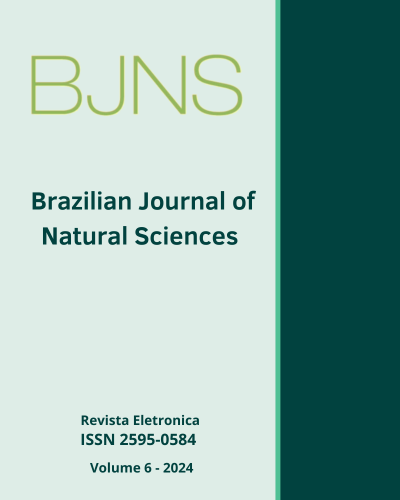Análise dermatológica sobre Paquioníquia Congênita: Relato de Caso
Main Article Content
Abstract
Pachyonychia Congenita is a rare autosomal dominant genodermatosis. The children of an individual with Pachyonychia Congenita have a fifty percent chance of inheriting the disorder, but it is difficult for individuals with this disease to access adequate genetic counseling. Approximately one thousand and thirty-eight cases have been reported worldwide, thirty in Brazil, according to the International Research Registry on Pachyonychia Congenita. The diagnosis is based on the classic triad that includes nail dystrophy, keratoderma and plantar pain. From a dermatological perspective, nail findings and oral leukokeratosis of the tongue are the earliest manifestations of the disease. Currently, due to the lack of knowledge of an effective therapeutic method for the disease, treatment plans, as well as follow-up, must be instituted individually. The objective is to highlight the specific clinical findings of Pachyonychia Congenita, in order to differentiate it from other possible diagnoses. The methodology used comprises the review of the individual's medical records, diagnosed during routine care at a reference hospital, located in São Paulo. It is concluded, therefore, that the doctor's control of this rare syndrome is essential both for early diagnosis and adequate treatment. In addition to promoting the dissemination of medical knowledge to the scientific community.
Keywords: Pachyonychia Congenita. Rare genodermatosis. Classical triad.
Article Details

This work is licensed under a Creative Commons Attribution-NonCommercial-NoDerivatives 4.0 International License.
Copyright Statement - Policy Proposal for Open Access Journals
Authors who publish in the Brazilian Journal of Natural Sciences (BJNS) agree to the following terms: 1 - Authors retain the copyright and grant the journal the right to first publication, with the work simultaneously licensed under the Creative Commons Attribution License allowing sharing of the work with recognition of the authorship of the work and initial publication in this journal. 2 - Authors are authorized to assume additional contracts separately, for non-exclusive distribution of the version of the work published in this journal (eg, publishing in institutional repository or as a book chapter), with acknowledgment of authorship and initial publication in this journal. 3 - Authors are allowed and encouraged to publish and distribute their work online (eg in institutional repositories or on their personal page) at any point before or during the editorial process, as this can generate productive changes, as well as increase the impact and citation of published work. This is an open access article under the CC-BY license
References
Nakamura R, Baran R. Doenças da unha, 2. ed. [livro]. Rio de Janeiro: Elsevier; 2018. [acesso em março de 2021] p. 97;98.
Smith FJD, Hansen CD, Hull PR, et al. Pachyonychia Congenita. 2006 Jan 27 [Updated 2017 Nov 30]. In: Adam MP, Ardinger HH, Pagon RA, et al., editors. GeneReviews® [Internet]. Seattle (WA): University of Washington, Seattle; 1993-2021. [acesso em abril de 2021]. Disponível em: https://www.ncbi.nlm.nih.gov/books/NBK1280/
Akasaka E, Nakano H, Nakano A, Toyomaki Y, Takiyoshi N, Rokunohe D, Nishikawa Y, Korekawa A, Matsuzaki Y, Mitsuhashi Y, Sawamura D. Diffuse and focal palmoplantar keratoderma can be caused by a keratin 6c mutation. Br J Dermatol. 2011 Dec;165(6):1290-2. [acesso em abril de 2021] doi: 10.1111/j.1365-2133.2011.10552.x. PMID: 21801157. Disponível em: https://pubmed.ncbi.nlm.nih.gov/21801157/
Rivitti E. Manual de dermatologia clínica de Sampaio e Rivitti. 1 ed. [livro]. São Paulo: Artes Médicas; 2014. [acesso em março 2021] p. 3; 11; 12.
Pachyonychia Congenita Project [página da internet]. Pachyonychia Congenita Project - PC Data [acesso em 25 de abril de 2021]. Disponível em: https://www.pachyonychia.org/
Al Aboud A, Al Aboud K. Josef Jadassohn (1863-1936), Felix Lewandowsky (1879-1921), and their syndrome. Clin Cosmet Investig Dermatol. 2011;4:179-82. doi: 10.2147/CCID.S27023. Epub 2011 Dec 6. [ acesso em abril de 2021] PMID: 22253542; PMCID: PMC3257882. Disponível em: https://pubmed.ncbi.nlm.nih.gov/22253542/
Samuelov L, Smith FJD, Hansen CD, Sprecher E. Revisiting pachyonychia congenita: a case-cohort study of 815 patients. Br J Dermatol. 2020 Mar;182(3):738-746. doi: 10.1111/bjd.18794. Epub 2020 Jan 14. [acesso em maio de 2021]. PMID: 31823354. Disponível em: https://pubmed.ncbi.nlm.nih.gov/31823354/
Eliason MJ, Leachman SA, Feng BJ, Schwartz ME, Hansen CD. A review of the clinical phenotype of 254 patients with genetically confirmed pachyonychia congenita. J Am Acad Dermatol. 2012 Oct;67(4):680-6. doi: 10.1016/j.jaad.2011.12.009. Epub 2012 Jan 20. [acesso em maio de 2021]. PMID: 22264670. Disponível em: https://pubmed.ncbi.nlm.nih.gov/22264670/
Leachman SA, Kaspar RL, Fleckman P, et al. Clinical and pathological features of pachyonychia congenita. The Journal of Investigative dermatology. Symposium Proceedings. 2005 Oct;10(1):3-17. [acesso em abril de 2021]. DOI: 10.1111/j.1087-0024.2005.10202.x. Disponível em: https://pubmed.ncbi.nlm.nih.gov/16250204/
Rugg EL. Therapeutic interference: a step closer for pachyonychia congenita? J Invest Dermatol. 2008 Jan;128(1):7-8. [acesso em abril de 2021] doi: 10.1038/sj.jid.5701065. PMID: 18071332. Disponível em: https://pubmed.ncbi.nlm.nih.gov/18071332/
Schwartz, Mary E.; Zimmerman, Gail M.; Smith, Frances; Sprecher, Eli Pachyonychia Congenita Project, Journal of the Dermatology Nurses’ Association: January/February 2013 - Volume 5 - Issue 1 - p 42-47. [acesso em abril de 2021]. doi: 10.1097/JDN.0b013e31827d9ed5. Disponível em: https://journals.lww.com/jdnaonline/toc/2013/01000
Almeida Jr. Hiram Larangeira de. Citoqueratinas. An. Bras. Dermatol. [Internet]. 2004 Apr [acesso em 2021 Mar 15] ; 79( 2 ): 135-145. Disponível em: http://www.scielo.br/scielo.php?script=sci_arttext&pid=S0365-05962004000200002&lng=en. http://dx.doi.org/10.1590/S0365-05962004000200002.
Goldberg I, Fruchter D, Meilick A, Schwartz ME, Sprecher E. Best treatment practices for pachyonychia congenita. J Eur Acad Dermatol Venereol. 2014 Mar;28(3):279-85. doi: 10.1111/jdv.12098. Epub 2013 Jan 30. [acesso em abril de 2021]. PMID: 23363249. Disponível em: https://pubmed.ncbi.nlm.nih.gov/23363249/
Milstone LM, Fleckman P, Leachman SA, Leigh IM, Paller AS, van Steensel MA, Swartling C. Treatment of pachyonychia congenita. J Investig Dermatol Symp Proc. 2005 Oct;10(1):18-20. [ acesso em abril de 2021]. doi: 10.1111/j.1087-0024.2005.10203.x. PMID: 16250205. Disponível em: https://pubmed.ncbi.nlm.nih.gov/16250205/


